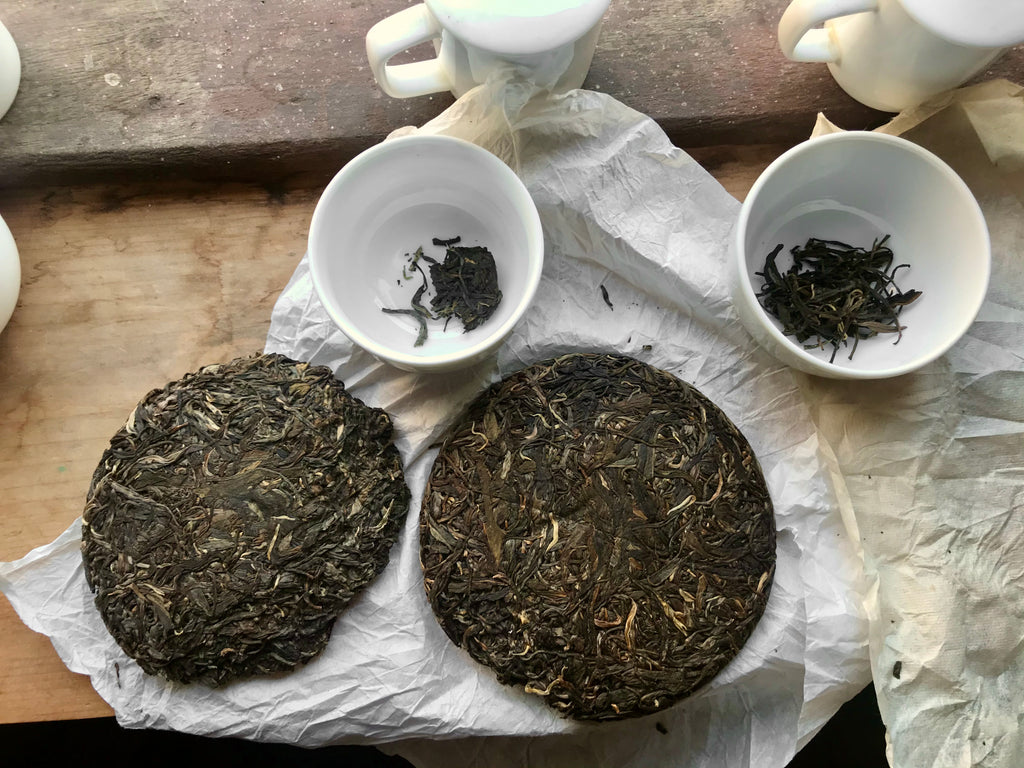Two Years In: An Encouraging Update About Our Pu-erh Storage Room

Do you see a difference between these two pu-erh bingchas?
Both were pressed from the same batch of tea harvested in the fall of 2016. Since then, one has been stored in a New York City apartment, in a ceramic crock with other pu-erhs and a salt packet for added humidity. The other has spent the last two years in our climate-controlled pu-erh storage room. Recently, we brought the teas back together for a blind tasting.
Take a closer look. The difference is slight; even in regions where pu-erh tea is traditionally stored, aging tea is a decades-long process. If you squint, the tea on the left may look a touch more green. This control bingcha was kept in New York City. The one on the right has been sealed in its original bamboo packaging, in the storage room.
In the cup, the visual differences disappear after a rinse.

But the nose tells a different story. The tea from the storage room has a richer, fuller and fruitier aroma in the infused leaf. The control tea from New York City smells more subtle, with some bitter green notes.
In the cup, the differences grow wider. We noticed that the storage-room tea had more body than the control. Since these are young sheng pu-erhs, the flavors are still green and arboreal, but it had hints of ripe fruit flavors like plum and cherry, along with a far more pronounced aftertaste that lingered in the throat minutes after sipping. The control tea, by comparison, was all around more muted. Not only did it taste greener than the storage room tea, but also like the flavor dial had been turned down a notch or two.
Soon after we brought this pu-erh to the U.S. in 2016, a friend tasted some and commented on a cooling effect he noticed in the throat and chest. In this tasting, we noticed that cooling effect in both teas had strengthened, but the experimental one balanced that coolness with the deep fruitiness absent in the control.

Not surprisingly, after such a relatively short duration, both bingchas taste and feel recognizably from the same batch, and they were both enjoyable to drink. If you were new to drinking pu-erh, you might not even notice a difference. It was like hearing the same word, but spoken by two distinct regional accents.
We also don't want to over-extrapolate: This was an experiment of just one tea tasted in one setting by a total of four people (following social distancing measures!). It's worth noting that the leaf used from the control tea—which had already been opened and consumed from for a few years—came from closer to the center of the cake, where compression can be tighter and aging slower, while the leaf from the experimental tea came more from the outer edge. One blind tasting is hardly ironclad evidence.
Yet if we had to pick just one of these bingchas to drink from, we all preferred the experimental one. So we're encouraged that the storage room is providing a beneficial aging environment for our compressed pu-erh teas, even with only modest added heat and humidity compared to popular regions for storage like Hong Kong, Taiwan and Malaysia.

This is the marvelous complexity of tea! Even within the same production batch from the same farm, brewed in the exact same way, you can make two different cups simply by storing your teas in different places.
It's also a reminder that when you buy an aged tea, part of what you're paying for is the storage method. As of now, most of our pu-erh bingchas are kept in this storage room instead of our warehouse, where the climate is controlled for fresh looseleaf teas from all the other categories.
We're excited for the future of these pu-erhs, and the sensory secrets they will continue to reveal to us.
